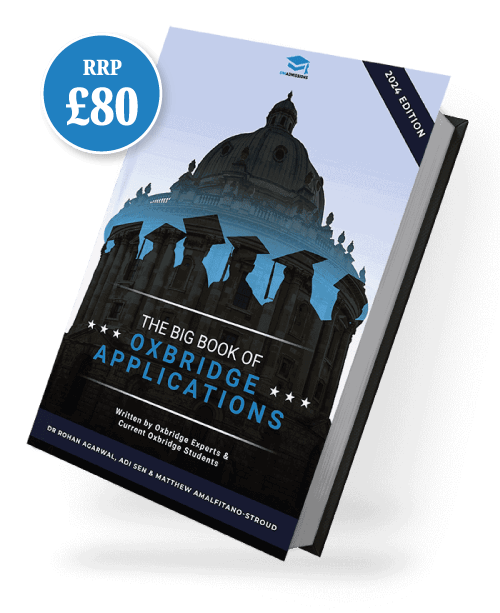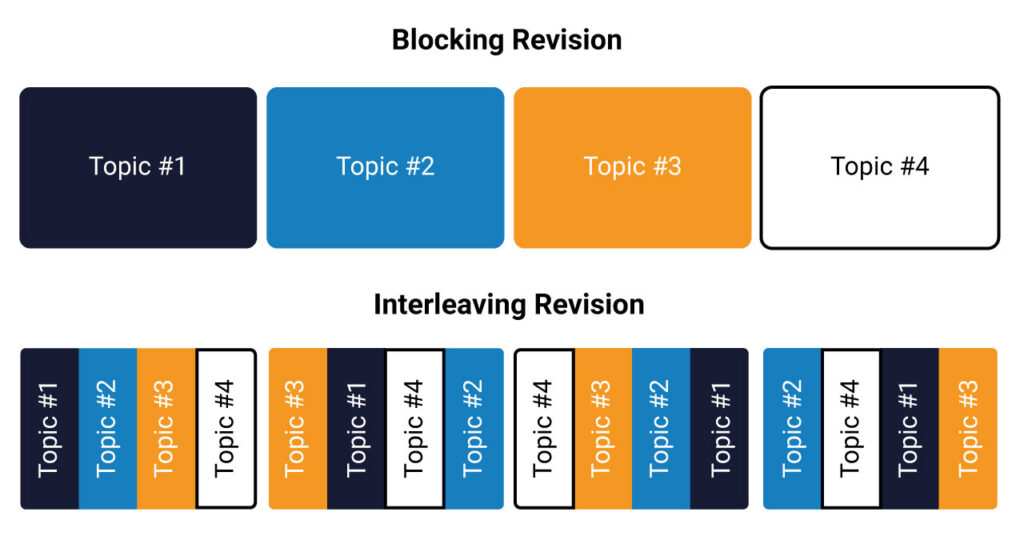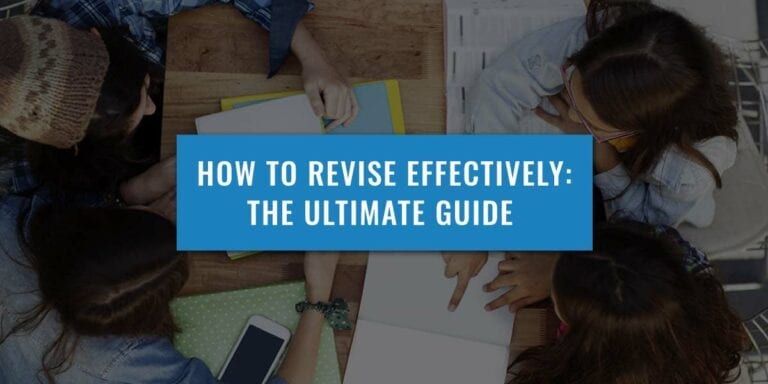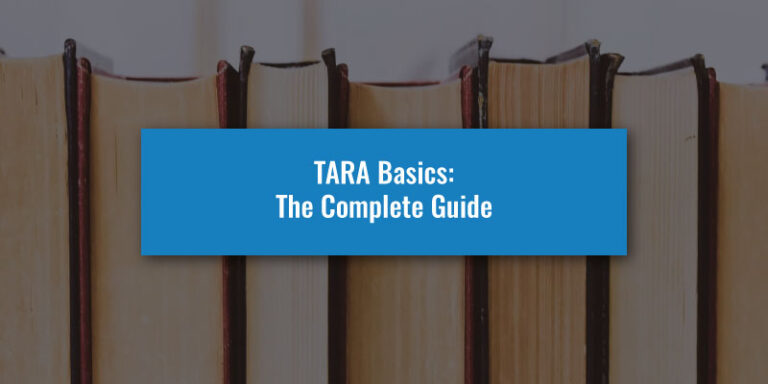Studying for your exams is usually a difficult and un-enjoyable process, especially for subjects you struggle with. However, if you feel like you’re not getting anywhere with your studies, the issue may be the method that you’re using.
Many students don’t consider the methods and strategies they use to approach their revision and even more use methods that don’t match their preferred style of working. Thankfully, there are various other ways to revise knowledge and prepare for tests, ranging from the Compound Effect to utilising AI tools.
In this guide, we’ll be focussing on one of the more well-known alternative study methods – Interleaving.
What is Interleaving?
Interleaving is a fairly popular form of studying that differs from the most common form of revision that most applicants utilise.
The word Interleave has multiple definitions, but the definition that is relevant to this study method is as follows:
Interleaving Definition
“To combine different things so that parts of one thing are put between parts of another thing.”
This definition forms the basis for how interleaving works in studying.
When you think about revision, most people will choose a subject, topic or question type to study and practice for a set period of time, usually around 1 to 2 hours. In a standard study session, a student may work on 3 – 4 different topics from one subject for equal amounts of time. This study method is referred to as Blocking.
As the definition suggests, Interleaving involves mixing multiple topics together in a set period of time, typically the same length of time that you would spend on one topic when using the Blocking study technique.
For example, let’s say that you plan to study four topics in a single day. If your day is broken up into four two-hour study sessions, Blocking would dictate that you cover one topic every two hours. However, Interleaving would mean that you cover each of the four topics for half an hour in each two-hour block, changing the order in which you approach them in each of the four sessions.
The exact amount of topics and time spent will vary from person to person, but the graphic below gives a clearer idea of what each study method would look like:
In other cases, you may want to add more topics into the mix, meaning you’ll be spending less time on each topic during the day but will have covered more topics overall. The principle is very customisable and can be altered to suit your needs and preferences.
We can see that this is a fairly different approach to studying, but is it actually beneficial?
Gain access to the most effective preparation method with UniAdmissions
At UniAdmissions, we have developed the formula for drastically increasing your chances of Oxbridge success. Our students are guided through a carefully planned curriculum that utilises a variety of support methods and is tailored to their specific needs.
Discover our Oxbridge Programmes below and find out how you can enrol and triple your chances of success.
Benefits of Interleaving
The benefits of mixing up your study in this way may not be initially obvious, as it can initially seem that you’re not giving yourself enough time to focus on one topic. However, various studies (including this 2016 study) have found that students who studied using the Interleaving method generally performed better than those who studied with blocking.
While there may be multiple reasons for this, there’s logical reasoning for why Interleaving may improve the retention of the work done in a student’s memory.
Interleaving improves long-term memory by enhancing the brain’s ability to retrieve information after a delay, as students will cover the same topic multiple times in a day with long breaks in between. It prevents the “blocking” effect, which occurs when prolonged focus on a single topic makes it harder to recall earlier material upon switching to a new topic. By interleaving, students engage in varied practice that strengthens memory connections and retrieval pathways.
As well as this, it allows students to make deeper connections between the topics they’re revising. For example, Mathematics is built upon a series of core principles that are essential across different disciplines in the subject. By studying multiple topics that all relate to one or more of these principles, the student should be able to understand the similarities between the topics, making it easier to utilise their understanding of one topic when looking at another.
Inversely, it also allows students to understand key differences between subjects, often referred to as Discrimination Learning. By knowing what makes topics different and similar to each other, it will be easier to use these connections when answering questions, as you will better understand what you’re dealing with and how to approach it.
From a less scientific standpoint, adding variety to your study routine will help to avoid burnout and procrastination. Interleaving inherently incorporates a form of spacing (spreading out work over a longer period), as you will only cover a specific topic for a set period of time before moving on and coming back to it later on.
This is great for studying topics you struggle with or don’t enjoy, as it eases the burden and provides more manageable timelines rather than requiring you to dedicate a whole study session to something you hate doing. Ideally, a standard Interleaving study session should have a good ratio of topics you enjoy, as they will provide respite from the topics you dislike. It will feel like less time has been spent working through it when you have actually spent the equivalent of a full study session on the topic.
Group Interleaving Sessions
Interleaving is a great option for both solo study and group study, so be sure to suggest it if your group hasn’t yet found an ideal revision method.
To successfully implement it, you’ll need to ensure your group has worked together to build a schedule that works for everyone. Ideally, each session should include topics that each member is either stronger or weaker in. That way, everyone will be able to benefit from both the interleaving study method and the expertise that the other group members can bring to the table.
Access "The Big Book Of Oxbridge Applications" For FREE
As well as learning effective study techniques, you’ll also need to learn about the Oxbridge application process itself. The Big Book Of Oxbridge Applications is available for free and will guide you through everything you need to know about getting into Oxford and Cambridge. Through over 350 pages, you will find:
- Proven A-Level study techniques
- 28 example Oxbridge Personal Statements
- Over 40 admissions test practice questions
- Interviews with Oxbridge students and graduates
- Additional downloadable resources
Fill in your details below to claim your digital copy today!

Interleaving For Oxbridge Applicants
You should now understand why Interleaving is an effective study technique, but how could it benefit you as an Oxbridge applicant? Outside of the obvious implementation of helping you study for your final exams, this method is study can also support you in another major part of your application – the admissions tests.
Interleaving For Admissions Test Preparation
Not every Oxbridge applicant has to sit an admissions test but the most popular courses do, so it’s likely that you will need to complete one. These admissions tests can vary a lot, meaning the implementation and effectiveness of Interleaving also differ.
For example, tests like the Mathematics Admissions Test (MAT) and the Test of Mathematics for University Admission (TMUA) are both fairly straightforward mathematics exams. They each have a set syllabus that covers a variety of topics, so using Interleaving to revise and practice this content will follow the standard process.
Some admissions tests, like the Physics Admissions Test (PAT), will cover more than one subject. In this case, the PAT features questions about both Mathematics and Physics, so your method of study may need altering. Some may wish to stick to one subject at a time, focusing on Maths one day and Physics the next. However, as the two subjects are very closely linked, it would also be possible to move from Maths topics to Physics topics within a single study session, although this may not be the most effective approach for everyone.
The most prominent example of a test like this would be the Engineering and Science Admissions Test (ESAT), which features five separate subtests based on Mathematics, Advanced Mathematics and the three core sciences. Naturally, each of these tests has a unique content specification. ESAT test takers only have to complete up to three of these subtests, so no applicant will need to revise everything included in the test, but it’s important to develop an effective strategy for splitting your time between the subtests you will need to complete.
These admissions tests are all quite similar to what you will be taking on in your A-Levels and beyond, but some admissions tests are far more unique and harder to revise in a traditional sense.
The most notable example of this is the University Clinical Aptitude Test (UCAT), which is required by all medical schools in the UK, not just Oxford and Cambridge. The UCAT consists of four subtests with varying question types. However, the entire test is based on general thinking skills rather than specific subject knowledge, so there isn’t any subject content to revise.
The UCAT can still be prepared for, but your time should be spent practising questions rather than revising knowledge. Interleaving is a great tactic for UCAT preparation sessions, as each subtest in the real exam doesn’t last more than 30 – 40 minutes anyway. By splitting your practice into half-hour slots, you will essentially be completing a more relaxed mock exam with looser time restrictions and without a set number of questions for each subtest.
The UCAT is all about answering questions fast, as you’ll generally have less than a minute to answer each question. If you want to reflect this in your Interleaving preparation, you could shorten your sessions per subtest to just ten minutes, five minutes or even change subtests per question. This tactic wouldn’t be recommended until you’re already very comfortable with the whole exam format, but it may be a fun way to increase the challenge in some of your later practice sessions.
Other tests at Oxford and Cambridge use a similar method of testing applicant’s general knowledge rather than subject knowledge, including the Law National Aptitude Test (LNAT) and Thinking Skills Assessment (TSA). However, these exams have less variance in their question types, so Interleaving may not be as helpful for these.
Finally, some admissions tests will be based on longer writing tasks rather than multiple-choice questions and problems. Tests like the History Admissions Test (HAT) can still be prepared for, but the Interleaving method won’t be as beneficial due to the lack of quick-fire questions. You could still use Interleaving when studying knowledge for these topics, but most of these kinds of tests do not include content specifications. Plus, some will not ask questions relating to subject knowledge, instead testing an applicant’s general writing skills with random or generic essay prompts.
Outside of admissions tests, Interleaving may also support you in your interview preparation, although its applications are more limited in this scenario. However, I hope this guide has shown you that approaching your studies in a different way can help you to learn more effectively and ultimately improve your exam performance.
If you’d like to learn more about the Oxbridge application process, we have a comprehensive selection of guides covering everything you need to know, all available for free. We can also support you with your application directly through our Oxbridge Programmes. You can learn more about how these programmes work and how you can enrol on our Programmes Page. Good luck with your studies!
Perfect your preparation with support from UniAdmissions
Secure your place to study at Oxford or Cambridge with our Half-Blue Oxbridge Programmes. You will receive complete guidance on everything from writing Personal Statements, acing your admissions test and answering the toughest interview questions.
Discover our Oxbridge Programmes below and find out how you can enrol and triple your chances of success.







